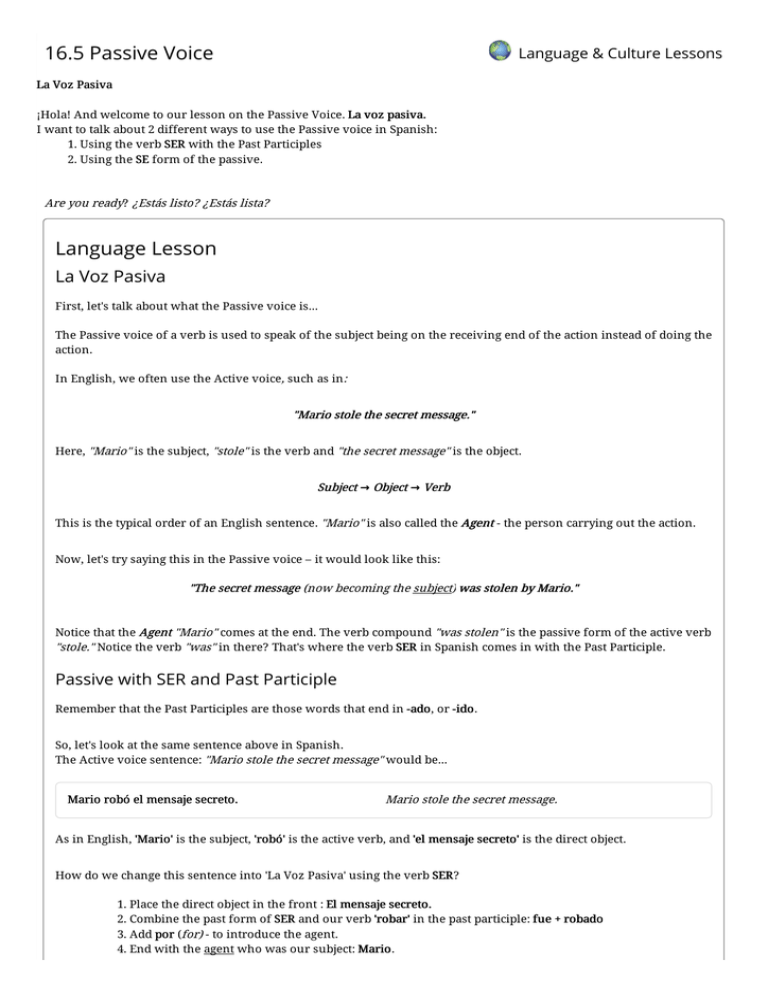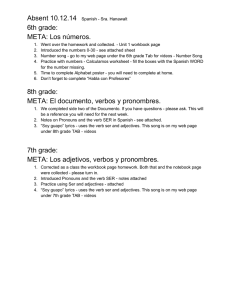16.5 Passive Voice Language Lesson
Anuncio

16.5 Passive Voice Language & Culture Lessons La Voz Pasiva ¡Hola! And welcome to our lesson on the Passive Voice. La voz pasiva. I want to talk about 2 different ways to use the Passive voice in Spanish: 1. Using the verb SER with the Past Participles 2. Using the SE form of the passive. Are you ready? ¿Estás listo? ¿Estás lista? Language Lesson La Voz Pasiva First, let's talk about what the Passive voice is... The Passive voice of a verb is used to speak of the subject being on the receiving end of the action instead of doing the action. In English, we often use the Active voice, such as in: "Mario stole the secret message." Here, "Mario" is the subject, "stole" is the verb and "the secret message" is the object. Subject → Object → Verb This is the typical order of an English sentence. "Mario" is also called the Agent - the person carrying out the action. Now, let's try saying this in the Passive voice – it would look like this: "The secret message (now becoming the subject) was stolen by Mario." Notice that the Agent "Mario" comes at the end. The verb compound "was stolen" is the passive form of the active verb "stole." Notice the verb "was" in there? That's where the verb SER in Spanish comes in with the Past Participle. Passive with SER and Past Participle Remember that the Past Participles are those words that end in -ado, or -ido. So, let's look at the same sentence above in Spanish. The Active voice sentence: "Mario stole the secret message" would be... Mario robó el mensaje secreto. Mario stole the secret message. As in English, 'Mario' is the subject, 'robó' is the active verb, and 'el mensaje secreto' is the direct object. How do we change this sentence into 'La Voz Pasiva' using the verb SER? 1. Place the direct object in the front : El mensaje secreto. 2. Combine the past form of SER and our verb 'robar' in the past participle: fue + robado 3. Add por (for) - to introduce the agent. 4. End with the agent who was our subject: Mario. El mensaje secreto fue robado por... The secret message was stolen by... The secret message was stolen by Mario. El mensaje secreto fue robado por Mario. ¡ATENCIÒN! The Past Participle and the object receiving the action (also called Recipient) must agree in number and gender. In other words, the form of the Past Participle will match the item that has been affected. In this case, 'El mensaje secreto' is a masculine, singular noun and 'fue robado' is also in the masculine, singular verb form. The pattern is as follows: [recipient] + SER + [past participle] + POR + [agent] All tenses of the verb SER are conjugated normally: Recipient Action 'SER' singular present es plural present son singular past fue plural past fueron singular future será plural future serán Por ejemplo: ACTIVE VOICE PASSIVE VOICE El autor escribe el libro. El libro es escrito por el autor. In this sentence, the object receiving the action (Recipient) is a masculine-singular noun: 'El libro' (the book). The Past Participle must agree in gender and number to the Recipient - so it takes the masculine-singular form of 'escribir' which is 'escrito'. Also, the form of SER must agree in number with the Recipient 'El libro' - so we end up with the following combination: [recipient] + El libro The book Otro ejemplo: SER es is + [past participle] escrito written + POR + [agent] por el autor. by the author. El niño será regañado por la maestra. The boy will be scolded by the teacher. ACTIVE VOICE The teacher will scold the boy. La maestra regañará al niño. PASSIVE VOICE The boy will be scolded by the teacher. El niño será regañado por la maestra. Here, the object receiving the action (Recipient) is a masculine-singular noun: 'El niño' (the boy). The Past Participle must agree in gender and number to the Recipient - so it takes the masculine-singular form of 'regañar': 'regañado' (scolded) The form of SER must agree in number with the Recipient 'El niño' - and, since the Active verb 'regañará' (will scold) refers to the future, we end up with the following combination: [recipient] + El niño The boy SER + será will be [past participle] + regañado scolded POR + [agent] por la maestra. by the teacher. Más ejemplos: ACTIVE VOICE María preparará la cena. María will prepare the dinner. PASSIVE VOICE La cena será preparada por María. The dinner will be prepared by María. ACTIVE VOICE Todos aman a Amy. Everyone loves Amy. PASSIVE VOICE Amy es amada por todos. ACTIVE VOICE Amy is loved by everyone. The father punished his son. El padre castigó a su hijo. PASSIVE VOICE The son was punished by his father. El hijo fue castigado por su padre. Voz pasiva refleja con SE If no "doer" is specified, that is, when the subject is inanimate and there is no specified agent of the action, the Passive SE construction is used. This is also know as as the Passive reflexive or Voz pasiva refleja. This type of passive is used when the agent is unimportant, unknown, or indefinite. Check out the following construction: [recipient] + SE + [3rd person singular or plural] Se + verb conjugated in the 3rd person singular or plural pattern for passive voice is much more frequently used in conversations. The verb appears in the third person, singular or plural, according to the subject. Here's an active Spanish sentence: El empleado abrió la tienda a las nueve. The employee opened the store at nine. Let's change this sentence into the passive voice using the SER + Past Participle construction - following the steps that we've learned above: [recipient] + La tienda The shop SER + fue was [past participle] abierta opened + POR + [agent] por el empleado. by the employee. The shop was opened by the employee La tienda fue abierta por el empleado. Now, when the agent or 'El empleado' (the DOER of the action) in not important or can be left out – that is, if the point you want to get across is that “the store opened at 9” regardless of who opened it, you can use the Voz pasiva refleja construction with SE: [recipient] + La tienda The shop La tienda se abrió a las nueve. SE + se was [3rd person singular] + [rest of sentence] abrió a las nueve. opened at nine. The store was opened at nine. The verb 'se abrió' agrees in number and gender with the third person singular, 'la tienda'. The SE is like an "indefinite subject" so it ends up meaning something like, "Someone did the action (of opening the store at 9)." Let's take a look at another example: Juan rompió la ventana ayer. Juan broke the window yesterday. Suppose you only wanted to focus on "the window" being broken yesterday. You can drop the agent "Juan" from the sentence making "the window" the recipient, or subject of our sentence: La ventana se rompió ayer. The window was broken yesterday. *Note that there is an agreement of the verb, being in the third person singular 'se rompió' with the new subject, which is also in the third person singular 'la ventana'. If we are speaking of more than one window breaking, we use a plural verb: Las ventanas se rompieron ayer. The windows were broken yesterday. Once again, there is an agreement of the verb, being in the third person plural 'se rompieron' with the new subject, which is also in the third person plural 'las ventanas'. ¡ATENCIÒN! When you use the SE passive, you can't use POR (for). So, if you want to name the agent, stick with the SER + Past Participle passive pattern. Culture Food in the Latin world Latin American cuisine is a mixture of Spanish inheritance with local ingredients and adaptations, where casseroles, doughs and potatoes are widely consumed. It's not difficult to find dishes of Mayan origin made with corn based products in Central America , or traces of Inca flavors in Peru, capital of the empire of Tupac Humaru. Perhaps it is the knowledge that comes with the background of a great empire that makes Peruvian cookery renowned worldwide. Peru can boast being the country with the most traditional dishes in the world - having an impressive number of nearly 500 traditional dishes! The fast food that Latin America offers is a combination of international and well known dishes, like hamburgers and pizzas, with local cuisine elements, like empanadas, burritos and arepas - a circular filled pastry or corn flour cake that can be steamed, baked, fried or boiled. And don't expect any Asian noodles at shopping malls, they barely exist at all! If you are a meat lover, Argentina and Uruguay are the places to go. Spicy? Mexico is the winner, with dangerous dishes for untrained stomachs. Slow baked dishes, the kind you would expect your granny to cook? Venezuela, Colombia and Chile. A taste of international flavors? Buenos Aires, the most European and fashionable city in Latin America. And for homesick stomachs, you can always get a burger with ketchup, but don't miss out on the exquisite cuisine experience on this side of the world - the Latin world. Libros Media Ltd. - Copyright 2004-2014 USA: 10660 Page Avenue, PO Box 1261, Fairfax, VA 22038, USA | Phone: 703-349-0452 Asia/Pacific: 2-1008 Ferry Road, Woolston, Christchurch 8023, New Zealand | Phone: +64-3-384-6350





